Porpoise Class: Difference between revisions
Pbcjohnston (talk | contribs) (→Pollack (SS-180): Added Pollack photo) |
Pbcjohnston (talk | contribs) (→Design and Construction Notes: Updated visual guide link) |
||
| (13 intermediate revisions by the same user not shown) | |||
| Line 2: | Line 2: | ||
=== <big>Design and Construction Notes</big> === | === <big>Design and Construction Notes</big> === | ||
<div style="text-align: justify;"><span style="color:#00008B">By 1933 the Navy had learned a lot from the largely experimental V-class fleet submarines. That experience led the Navy to design the Porpoise class of fleet submarines, a refinement of the earlier [[Dolphin|'''Dolphin''']] and [[Cachalot and Cuttlefish|'''Cachalot''']]. The National Industrial Recovery Act of 1933 provided needed money to spur shipbuilding in the U.S. and the Navy took advantage by ordering four submarines for Fiscal Year 1934. Now with firm reins on the submarine acquisition process, the Navy ordered two of these boats (Porpoise & Pike) to be built at the Portsmouth Navy Yard in Kittery, ME., and two (Shark & Tarpon) from the revitalized Electric Boat Company (EB) of Groton, CT. The Navy allowed EB to build its two boats to a divergent, but similar design that used a welded partial double hull. Portsmouth, still not convinced of the efficacy of welding, built its two boats to a traditional riveted full double hull design. All four boats had the same armament, engineering plants, and performance so they were considered to be in the same class despite the different hull form. FY-35 appropriations approved funds for six more boats, | <div style="text-align: justify;"><span style="color:#00008B">By 1933 the Navy had learned a lot from the largely experimental V-class fleet submarines. That experience led the Navy to design the Porpoise class of fleet submarines, a refinement of the earlier [[Dolphin|'''Dolphin''']] and [[Cachalot and Cuttlefish|'''Cachalot''']]. The National Industrial Recovery Act of 1933 provided needed money to spur shipbuilding in the U.S. and the Navy took advantage by ordering four submarines for Fiscal Year 1934. Now with firm reins on the submarine acquisition process, the Navy ordered two of these boats (Porpoise & Pike) to be built at the Portsmouth Navy Yard in Kittery, ME., and two (Shark & Tarpon) from the revitalized Electric Boat Company (EB) of Groton, CT. The Navy allowed EB to build its two boats to a divergent, but similar design that used a welded partial double hull. Portsmouth, still not convinced of the efficacy of welding, built its two boats to a traditional riveted full double hull design. All four boats had the same armament, engineering plants, and performance so they were considered to be in the same class despite the different hull form. FY-35 appropriations approved funds for six more boats, and the Navy decided to standardize on the EB style partial double hull for all six. | ||
The Perch group consisted of two boats built at Portsmouth, one at Mare Island, and three built by EB. The three Navy yard boats were the last riveted submarines for the Navy, while the EB boats were fully welded. The ten boats of the Porpoise class also set a new precedent: they were the first USN submarines to have all-electric drive. All previous submarines were equipped with direct drive diesel engines. For the Porpoise class the engines drove only generators and were not connected directly to the propeller shafts. The electricity they generated drove motors attached to the shafts or recharged the massive storage batteries. | The Perch group consisted of two boats built at Portsmouth, one at Mare Island, and three built by EB. The three Navy yard boats were the last riveted submarines for the Navy, while the EB boats were fully welded. The ten boats of the Porpoise class also set a new precedent: they were the first USN submarines to have all-electric drive. All previous submarines were equipped with direct drive diesel engines. For the Porpoise class the engines drove only generators and were not connected directly to the propeller shafts. The electricity they generated drove motors attached to the shafts or recharged the massive storage batteries. | ||
Most of the boats received modifications and modernizations during the war. Their fairwaters were cut down to lessen the overall silhouette, and they received additional or upgraded gun armament, radar, and other improvements. During overhauls in 1942 Porpoise, Pike, Tarpon, Pickerel, and Permit were fitted with two additional external forward firing torpedo tubes in the superstructure just below the main deck forward of the bow planes. This was a belated attempt at increasing firepower, but the experiment was not successful. | |||
These boats were in the thick of the fight against the Japanese from the first day of the war. Four of them (marked by a *) and their brave crews were lost in action and are considered to be "on eternal patrol". | These boats were in the thick of the fight against the Japanese from the first day of the war. Four of them (marked by a *) and their brave crews were lost in action and are considered to be "on eternal patrol". | ||
'''Note'''... many early photos of these boats will show them with large "P" identifiers painted on their bows and fairwaters. These were used to identify the boats visually while on the surface. They were NOT their names or designations. The use of these identifiers was common on the fleet boats | '''Note'''... many early photos of these boats will show them with large "P" class identifiers painted on their bows and fairwaters. These were used to identify the boats visually while on the surface. They were NOT their names or designations. The use of these identifiers was common on the fleet boats but faded out in favor of hull numbers in 1939 because their use became confusing. | ||
There were a lot of variations in the external appearance of these boats over the years. For a thorough explanation of these changes, please take a few minutes to read [ | There were a lot of variations in the external appearance of these boats over the years. For a thorough explanation of these changes, please take a few minutes to read [https://pigboats.com/images/e/e4/A_VISUAL_GUIDE_TO_THE_FLEET_SUBMARINES_PART_2_Porpoise_Class_2023.pdf '''this article'''].</span></div> | ||
[[File:Red bar sub new 2.jpg]] | [[File:Red bar sub new 2.jpg]] | ||
| Line 31: | Line 33: | ||
[[File:Red bar sub new 2.jpg]] | [[File:Red bar sub new 2.jpg]] | ||
<div style="text-align: justify;"><span style="color:#000000"> | |||
=== <big>Shark (SS-174)*</big> === | === <big>Shark (SS-174)*</big> === | ||
[[File: | </div> | ||
<div style="text-align: justify;"><span style="color:#00008B"> | |||
[[File:Shark port side.jpg|left|500px|U.S. Navy photo.]] | |||
<div style="text-align: justify;"><span style="color:#00008B">Shark underway at an unknown location, approximately 1936-1937. Shark has a mount on the forward deck for a water-cooled M2 .50 caliber machine gun. The gun itself is detached from the mount and taken below when not in use. There is another mount like this on the cigarette deck in the aft end of the conning tower fairwater. | |||
[[174|See more Shark photos]] | [[174|See more Shark photos]] | ||
[[File:Red bar sub new 2.jpg]] | [[File:Red bar sub new 2.jpg]] | ||
<div style="text-align: justify;"><span style="color:#000000"> | |||
=== <big>Tarpon (SS-175)</big> === | === <big>Tarpon (SS-175)</big> === | ||
</div> | |||
[[File:H41921b.jpg|left|500px|NHHC photo NH 41921 courtesy of the Naval History & Heritage Command.]] | [[File:H41921b.jpg|left|500px|NHHC photo NH 41921 courtesy of the Naval History & Heritage Command.]] | ||
<div style="text-align: justify;"><span style="color:#00008B">Tarpon shown underway circa 1937. Location is most likely San Diego with the Point Loma headlands in the background. On the forward deck is the round ball of the JK sonar. Immediately aft of that is the mount for a M2 .50 caliber water-cooled machine gun. The gun has been dismounted and taken below, a common procedure. On the aft deck is the 3"/50 caliber Mk 6 deck gun. The topside is festooned with lifelines, radio aerial wires, and masts. This was a typical appearance for a fleet boat of this era.</span> | <div style="text-align: justify;"><span style="color:#00008B">Tarpon shown underway circa 1937. Location is most likely San Diego with the Point Loma headlands in the background. On the forward deck is the round ball of the JK sonar. Immediately aft of that is the mount for a M2 .50 caliber water-cooled machine gun. The gun has been dismounted and taken below, a common procedure. On the aft deck is the 3"/50 caliber Mk 6 deck gun. The topside is festooned with lifelines, radio aerial wires, and masts. This was a typical appearance for a fleet boat of this era.</span> | ||
| Line 47: | Line 57: | ||
[[File:Red bar sub new 2.jpg]] | [[File:Red bar sub new 2.jpg]] | ||
<div style="text-align: justify;"><span style="color:#000000"> | |||
=== <big>Perch (SS-176)*</big> === | === <big>Perch (SS-176)*</big> === | ||
[[File: | </div> | ||
<div style="text-align: justify;"><span style="color:# | |||
[[File:Perch at Curacao.jpg|left|500px|U.S. Navy photo.]] | |||
<div style="text-align: justify;"><span style="color:#00008b">In the spring of 1939, Perch operated with the fleet on its cruise to the east coast. Even though assigned to the Pacific Fleet at the time, Perch went through the canal and operated briefly with the fleet on the Atlantic side. This photo shows the Perch in the Dutch port of Willemstad Harbor, island of Curaçao, taken in the spring/summer of 1939. The crew on deck are facing away from the camera and at attention. In the upper right corner a large square building can be seen. This might be a Governmental building of some kind. | |||
[[176|See more Perch photos]] | [[176|See more Perch photos]] | ||
[[File:Red bar sub new 2.jpg]] | [[File:Red bar sub new 2.jpg]] | ||
<div style="text-align: justify;"><span style="color:#000000"> | |||
=== <big>Pickerel (SS-177)*</big> === | === <big>Pickerel (SS-177)*</big> === | ||
[[File: | </div> | ||
<div style="text-align: justify;"><span style="color:#00008B"> | |||
[[File:Pickerel from port side NH 42614.jpg|left|500px|Photo NH 42614 courtesy of NHHC.]] | |||
<div style="text-align: justify;"><span style="color:#00008B">Pickerel on her sea trials after commissioning, possibly in the Atlantic off Block Island, spring of 1937. The P6 class identifier would be done away with in favor of her hull number a year and a half after this photo was taken.</span> | |||
[[177|See more Pickerel photos]] | [[177|See more Pickerel photos]] | ||
[[File:Red bar sub new 2.jpg]] | [[File:Red bar sub new 2.jpg]] | ||
<div style="text-align: justify;"><span style="color:#000000"> | |||
=== <big>Permit (SS-178)</big> === | === <big>Permit (SS-178)</big> === | ||
</div> | |||
[[File:178-4a.jpg|left|500px|National Archives photo]] | [[File:178-4a.jpg|left|500px|National Archives photo]] | ||
<div style="text-align: justify;"><span style="color:#00008B">Permit entering port in 1938, the location is most likely San Diego, with Point Loma in the background. </span> | <div style="text-align: justify;"><span style="color:#00008B">Permit entering port in 1938, the location is most likely San Diego, with Point Loma in the background. </span> | ||
| Line 71: | Line 93: | ||
[[File:Red bar sub new 2.jpg]] | [[File:Red bar sub new 2.jpg]] | ||
<div style="text-align: justify;"><span style="color:#000000"> | |||
=== <big>Plunger (SS-179)</big> === | === <big>Plunger (SS-179)</big> === | ||
</div> | |||
[[File:P8-2.jpg|left|500px|National Archives photo]] | [[File:P8-2.jpg|left|500px|National Archives photo]] | ||
<div style="text-align: justify;"><span style="color:#00008B">This is a nice photo of Plunger with a portion of her crew on deck, circa 1937. The location was originally thought to be in the East River under the Brooklyn Bridge, but the details don't match the bridge's structure. She is most likely entering port, as this number of crew lined up on deck would not be common if she was leaving port. Any help with the location would be appreciated.</span> | <div style="text-align: justify;"><span style="color:#00008B">This is a nice photo of Plunger with a portion of her crew on deck, circa 1937. The location was originally thought to be in the East River under the Brooklyn Bridge, but the details don't match the bridge's structure. She is most likely entering port, as this number of crew lined up on deck would not be common if she was leaving port. Any help with the location would be appreciated.</span> | ||
| Line 79: | Line 105: | ||
[[File:Red bar sub new 2.jpg]] | [[File:Red bar sub new 2.jpg]] | ||
<div style="text-align: justify;"><span style="color:#000000"> | |||
=== <big>Pollack (SS-180)</big> === | === <big>Pollack (SS-180)</big> === | ||
</div> | |||
[[File:Pollack from stbd.jpg|left|500px|U.S. Navy photo]] | [[File:Pollack from stbd.jpg|left|500px|U.S. Navy photo]] | ||
| Line 88: | Line 117: | ||
[[File:Red bar sub new 2.jpg]] | [[File:Red bar sub new 2.jpg]] | ||
<div style="text-align: justify;"><span style="color:#000000"> | |||
=== <big>Pompano (SS-181)*</big> === | === <big>Pompano (SS-181)*</big> === | ||
[[ | </div> | ||
<div style="text-align: justify;"><span style="color:#00008B"> | |||
[[File:Pompano post launch.jpg|left|500px|U.S. Navy photo.]] | |||
<div style="text-align: justify;"><span style="color:#00008B">Pompano on her launch day, March 11, 1937, at the Mare Island Navy Yard, Vallejo, CA. Her launch cradle is seen floating in the water near her bow. It would be recovered and reused for another boat. In order to spread out contracts for engines and provide redundant suppliers, the Navy choose the double acting Model 89DA from the Hooven, Owens, Rentschler Company (HOR) for Pompano. When Pompano began her sea trials in late 1937 she didn't even make it out of the yard before all four engines wrecked themselves due to excessive vibration and improperly forged gearing. The engines had to be removed and sent back to the factory in Hamilton, OH. to be rebuilt. While on the test stand there they failed again. The Pompano sat immobile at Mare Island for over eight months while the Navy and HOR worked through the problems. The engines were repaired and reinstalled and through very careful maintenance they were coddled along until 1942 when wartime funds were available to replace them with well-liked Fairbanks Morse engines. The HOR story was a sad one that affected not only Pompano but several other boats as well.</span> | |||
[[181|See more Pompano photos]] | [[181|See more Pompano photos]] | ||
[[File:Red bar sub new 2.jpg]] | [[File:Red bar sub new 2.jpg]] | ||
<div style="text-align: justify;"><span style="color:#000000"> | |||
=== <big>General Porpoise Class photos</big> === | === <big>General Porpoise Class photos</big> === | ||
[[photo]] | </div> | ||
<div style="text-align: justify;"><span style="color:#00008B"> | |||
[[File:Porpoise class boats.jpg|left|500px|U.S. Navy photo.]] | |||
<div style="text-align: justify;"><span style="color:#00008B">A large group of Porpoise class submarines at San Diego 1939-1940. From left to right: unknown, [[174|'''Shark (SS-174)''']], [[178|'''Permit (SS-178)''']], [[176|'''Perch (SS-176)''']], [[172|'''Porpoise (SS-172)''']], [[175|'''Tarpon (SS-175)''']], and [[173|'''Pike (SS-173)''']]. Note the detail differences in the shape and configuration of the conning tower fairwaters and periscope shears.</span> | |||
[[General Porpoise Class Photos|See more general Porpoise Class photos]] | [[General Porpoise Class Photos|See more general Porpoise Class photos]] | ||
Latest revision as of 18:12, 11 May 2024
Design and Construction Notes
The Perch group consisted of two boats built at Portsmouth, one at Mare Island, and three built by EB. The three Navy yard boats were the last riveted submarines for the Navy, while the EB boats were fully welded. The ten boats of the Porpoise class also set a new precedent: they were the first USN submarines to have all-electric drive. All previous submarines were equipped with direct drive diesel engines. For the Porpoise class the engines drove only generators and were not connected directly to the propeller shafts. The electricity they generated drove motors attached to the shafts or recharged the massive storage batteries.
Most of the boats received modifications and modernizations during the war. Their fairwaters were cut down to lessen the overall silhouette, and they received additional or upgraded gun armament, radar, and other improvements. During overhauls in 1942 Porpoise, Pike, Tarpon, Pickerel, and Permit were fitted with two additional external forward firing torpedo tubes in the superstructure just below the main deck forward of the bow planes. This was a belated attempt at increasing firepower, but the experiment was not successful.
These boats were in the thick of the fight against the Japanese from the first day of the war. Four of them (marked by a *) and their brave crews were lost in action and are considered to be "on eternal patrol".
Note... many early photos of these boats will show them with large "P" class identifiers painted on their bows and fairwaters. These were used to identify the boats visually while on the surface. They were NOT their names or designations. The use of these identifiers was common on the fleet boats but faded out in favor of hull numbers in 1939 because their use became confusing.
There were a lot of variations in the external appearance of these boats over the years. For a thorough explanation of these changes, please take a few minutes to read this article.Porpoise (SS-172)
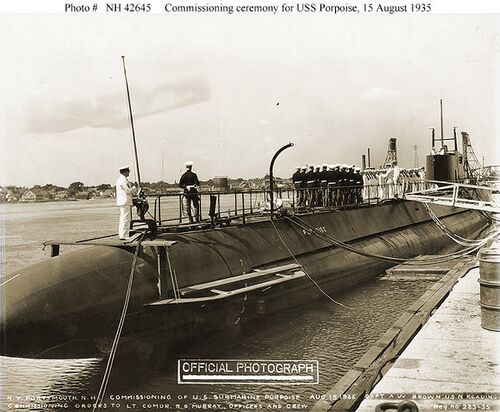
Pike (SS-173)
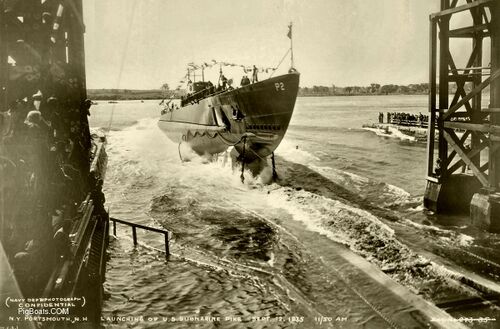
Shark (SS-174)*
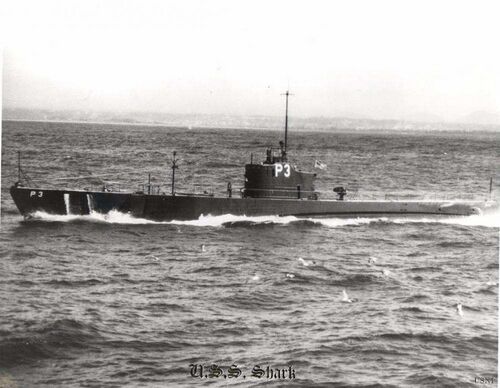
Tarpon (SS-175)
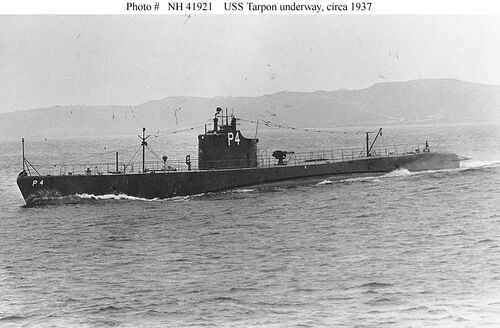
Perch (SS-176)*
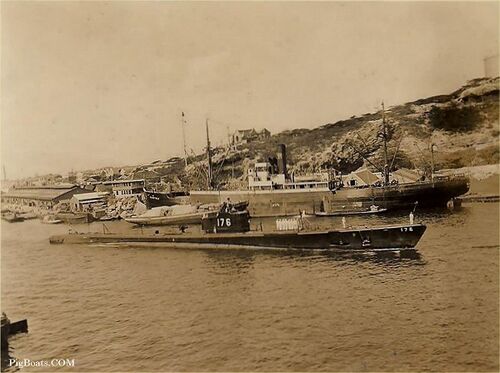
Pickerel (SS-177)*
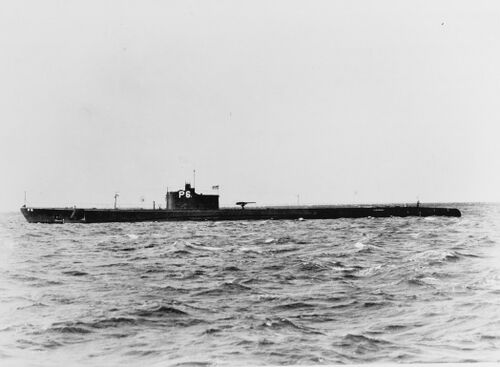
Permit (SS-178)
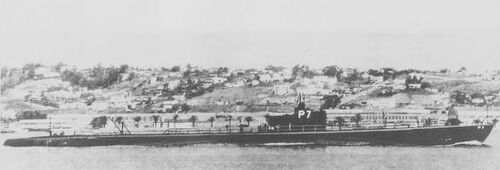
Plunger (SS-179)
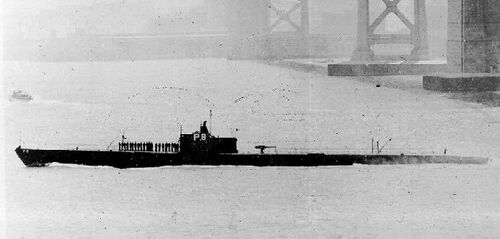
Pollack (SS-180)

Pompano (SS-181)*
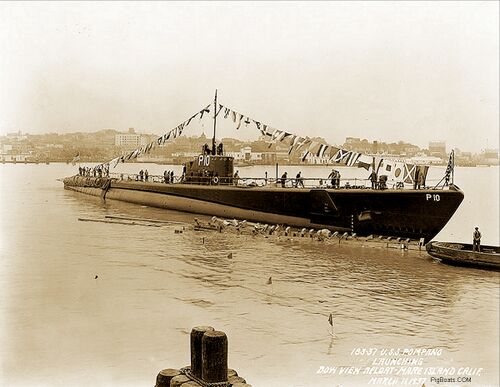
General Porpoise Class photos
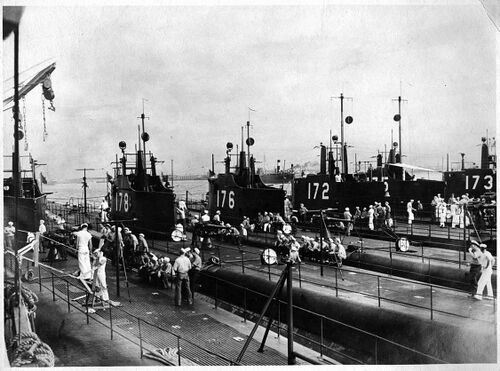
See more general Porpoise Class photos
Page created by:
Ric Hedman & David Johnston
1999 - 2023 - PigBoats.COM©
Mountlake Terrace, WA, Norfolk, VA
webmaster at pigboats dot com
